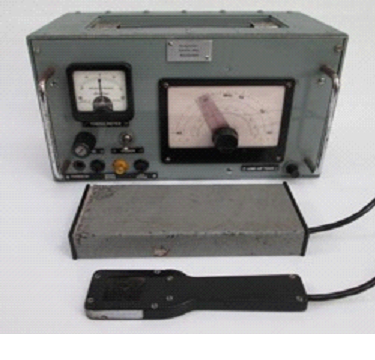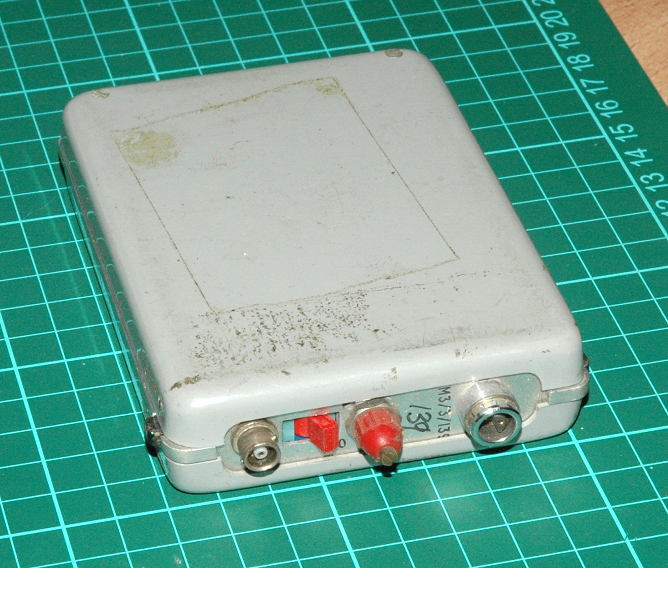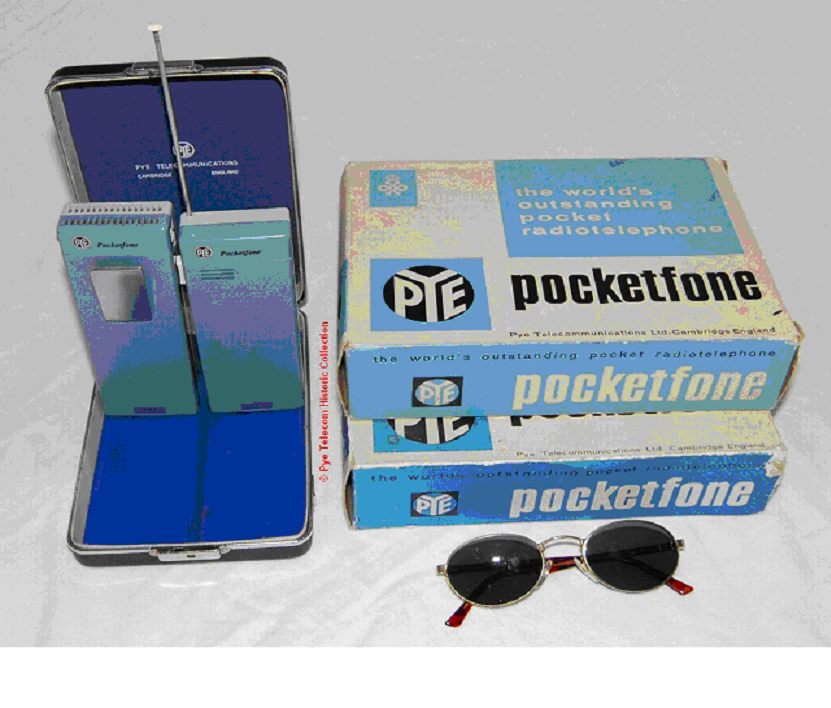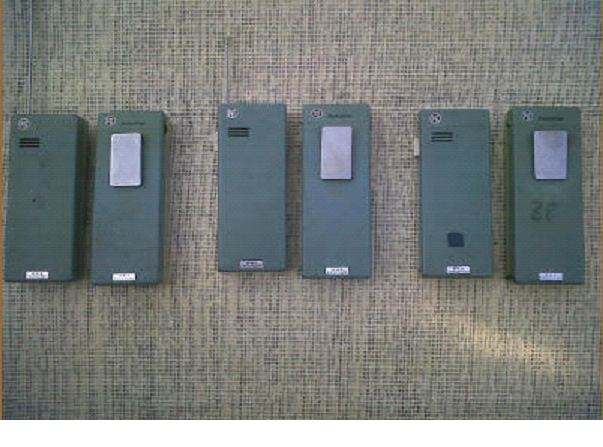Alan Taylor
All this talk of mountaineering (see The Old Man of Hoy) reminds me that it was a type of programme which only became practical to cover live once radio microphones were available. The research I’ve been doing has hit the buffers with regards to radio microphones, so it seems like an opportune moment to ask the chaps on this group what they can remember.There is very little information about early radio mics on the internet, in trade journals or books about broadcasting. I clearly recall the BBC Band I radio mics which at Kendal Avenue were operated by Eric Spanier for many years and then by Richard Kemp. Here’s a picture of the receivers used, but I don’t recognise the two objects in the foreground, any ideas?

There was a later generation of BBC radio mic using a rectangular battery with tiny plug and socket connectors. Does anybody have any info, memories or pictures of them?
I’ve tried to find any BBC manuals for them or research notes concerning radio mics, but have drawn a blank. The only research note I’ve found so far has concerned propagation of radio signals within studios and how it is affected by scenery.
The LO21 project have mentioned that LO21 originally incorporated two Eddystone radio receivers, but I’m pretty sure that they had been replaced with BBC receivers by the time I worked on it after it’s conversion to colour. Does anybody know what type of transmitters were used originally?
I also have vague recollections of using Vega radio mics before Microns cornered the market. Does anybody remember them?
While I’m asking, there are a few other topics where more information would be useful.
“Saturday Night Live” – is there anybody still around who worked on those shows? I know about some of the infamous incidents. Does anybody have any personal recollections?
“Bucknell’s House” – What sound equipment was installed in that dedicated scanner? Was Barry on a radio mic, or did he use something like a cabled, neck worn AKG D109 ? Did they have a radio talkback system for the FM, or was it done on long-lead cans? Any memories of that series?
Radio talkback – I remember a BBC designed valve radio talkback transmitter. John Livingstone was so infuriated with it that he ‘accidentally’ dropped it down some concrete stairs, swept up the wreckage into a bag and sent it to sound test room with a fault label on it hoping that it would be regarded as a write-off and end up in a skip. A month or so later, he was exasperated to discover that one of the engineers relished the opportunity to work with valves again and lovingly repaired it. I also remember the BBC designed radio talkback system which had two separate units for the floor manager. One was the transmitter, the other the receiver. They walked about looking like a gunslinger with these units fastened either side of their belt. Power came from a 9 Volt PP4 battery ( about the size of a ‘C’ cell with a snap on stud at either end ), specially selected so that you stood no chance of finding one in any normal shop. There were two major problems. One was that the base station radiated so much spurious radiation on Band I that when a scanner set up in a street, it blotted out reception of 405 line BBC television signals, which didn’t do a lot to make us popular. with the locals. Designs Department rose to the occasion, did their sums concerning inductors and capacitors and built a passive filter to fit inline with the aerial lead. They tried it and it was discovered that it completely cancelled out the wanted signal, while allowing all the spurious radiation through. That’s the day when they realised the important difference between connecting the components in series or parallel. Fortunately it was only necessary to rewire the parts the other way to get the intended function.
The second major problem was that when the FM transmitted, it blasted into his receiver making a deafening noise in his headphones. That particular problem was trickier to resolve and I don’t think it ever got properly sorted. Fortunately Storno radios soon replaced them and subsequently Motorolas.
PBX and EMX systems – Early scanners used telephones with ringing generators, you could use ex-army field telephones and wind the handle to alert the other end. From memory, I think that all trucks up to and including the type II scanners used that system, but will check with North 3. However I’m pretty sure that the type 5 scanners originally had a BBC designed telephone system which turned out to be something of a liability and was scrapped in favour of an off the shelf system. Can anybody fill in the blanks in my memory?
Labor gun mics – They were widely used before Sennheiser 816 microphones ( Labor was part of the Sennhesier group anyway ). Does anybody have any pictures of one in use? The one metre long microphone was often to be seen mounted on a ‘U’ shaped cradle on top of early colour cameras. The Labor gun mic had a distinctive teardrop shaped thicker part at the back and I don’t think they ever had an external windshield similar to Rycote housings. These microphones have almost completely vanished without trace. On a similar subject, does anybody have any pictures or recollections of the Electrovoice 7 foot gun mic in use on a programme? I remember operating one on the centre line of the basketball court, covering the Harlem Globe Trotters in the early 1970s. It was the most unwieldy thing imaginable for covering such a fast moving event. Where else was it used?
Any contributions on associated topics would also be most welcome.
John Nottage
I’m sure the items at front of the photo are lighting connectors: Kliegl (or something like that) used by Lee Lighting.- see Completely Shocking ….I found a photo of the 7ft Electrovoice on line. I’ll post it from my desktop.
The black block batteries were surely from the next generation of radio mics after the TM3s: rather more reliable than the awful triangular ones.
I remember the twin unit radio talkback: lots of the batteries were rubbish, so we got through dozens. I remember hanging set on the scanner door, then someone closed the door! The telescopic aerial ended up a lovely kinked shape. We used them on “Jude the Obscure” in Oxford and blotted out the local TV station.
Dave Mundy
TM3 – correct, Eddystone RX – correct (different to the one in the picture) Kalium – correctBatphones in type 5 scanners (multiplexed system – a p.i.t.a!) changed to Philips KBX in type 8s. Field telephones TeleF) -brown with winder, followed by GPO green 704A with 9 U2s.
Dave Plowman
I can just remember being shown a BBC valve radio mic in the early 1960s -perhaps kept at TV theatre? Used pretty massive carbon cell battery packs.Alan Taylor
My story about those BBC hip flask radio mics concerns Paul Daniels, who was relatively unknown at the time, but appeared on a “Seaside Special” from Southsea in 1976.Paul had to be put on a higher frequency than the other artists because the wire aerial could be shorter for higher frequencies, his little legs could not accommodate a longer aerial. While I was rigging it onto him, he was in jocular mood and I joked, “Now I want you to promise that when I take this off you, it won’t be covered in feathers and dove shit … I know what you magicians are like and other artists need to use this transmitter”. He laughed and explained that he wasn’t that type of magician.
He chilled for a quite few minutes before his turn, did his act, returned backstage and made ready for me to remove his transmitter. When I pulled out the aerial lead it was followed by yards and yards of silk flags of many nations. Paul had done his entire show with his sock stuffed full of those flags just so that he could have a laugh backstage.
He had borrowed the flags from Barry Walls, who worked at Gerry Cottle’s circus. Barry did everything from sign-writing the circus vans to a fakir act, he also performed on stilts and was a clown too. Paul had already struck up a friendship with Barry and asked him if he had some of those flags. Some of you may have subsequently met Barry because at one time he used to run a magic and joke shop in Hammersmith called Joker. It was owned by Paul Daniels and Barry ran it.
A few years later I did a series of inserts into a Paul Daniels show. It was rather like Candid Camera or Noel’s Hit Squad. This particular jape involved Paul dressed as an Arab Sheik. The sheik only spoke ( mock ) Arabic and conversed entirely through an interpreter ( a rather young Jeremy Beadle – who was unknown at that time. The female accomplice was Pamela Stevenson, who was just starting to be famous ). Barry Walls had been invited along to demonstrate some of the magic tricks and jokes from his shop as the sheik was planning a lavish birthday party for many of his children. Paul egged Barry on to do increasingly absurd things and loudly laughed in appreciation at his antics. Through the interpreter Paul told Barry that he was a wonderful magician, even better than that so called magician Paul Daniels who he had seen on the television. Barry confided, “Actually Paul Daniels is an even better magician than me”, all the time while standing three feet away from Paul and looking him in the face.
Roger Long
My TFS memories from 1967 onwards was a BBC design dept aluminium hip flask, one pint size and a long wire antennae: not very reliable.Audio Ltd next, FM in a teak box with whip Rx antenna and short quarter wave wire sender, again unreliable.
Then in 1970 Micron from Audio Engineering, hi tech and reliable with Sony ecm 50. Really good SQ and easily tweaked for line use and boom wireless. You could use 3 together if you were lucky.
Thence diversity and perhaps 6 if the wind was southerly.
Now a hundred channels of digital!
Alan Taylor
At Kendal Avenue, our experience was that the BBC hip-flask radio mics were often unreliable when issued via tech stores and used by the crews. Then Colin White decided to appoint Eric Spanier as the radio mic specialist. I don’t think that Eric would have objected to being described as an odd ball character, but he really came into his own with the radio mics, badgering the presenters to treat the equipment with respect, looking after the gear carefully and making sure that the production teams had realistic expectations of what could be expected. That’s not to say that they never went wrong, but the reliability improved tremendously.After Eric’s retirement, Richard Kemp took over the same role. Richard and Eric’s expertise was put to the test on shows like live climbing coverage, or golf, where extreme radio ranges were expected under less than ideal conditions and often in atrocious weather. Their secret weapon was often to use a booster which took the radio mic transmitter and massively increased the power. You might well have seen people wearing what appears to be rucksacks with a tall aerial, walking alongside the players on golf courses.
When Microns came along, most of us discovered the hard way that they would not work reliably with more than a few channels in use simultaneously. One year I was working on the Royal Variety show and the theatre sound people had a rack of maybe 18 Microns working together perfectly. The gear was provided by Autograph Sound. Shortly after that I was promoted to Sound Supervisor and when I mixed a live music show where we needed a dozen reliable radio mics, I got permission to book Autograph Sound to provide and operate them. They did a great job and we didn’t have any problems at all.
Modern radio mics are great, but one type of show which I regularly did was very stressful with regards to radio mics. I used to cover a lot of big movie premiers from Leicester Square. The technical requirements weren’t that extensive, just a few radio mics, cabled stand-by mics, effects mics and VT. The problem was that on an event as big as a Bond premiere, maybe a hundred single-camera crews would turn up near the last minute and most of them brought a radio mic or two. You could almost guarantee that while you were doing the live coverage some foreign crew would illicitly pop up on your properly licensed radio mic frequency. Getting through the crowds to locate the pirate transmitter was almost impossible. The presenters often worked over a large area and arranging cabled standby mics was tricky. Occasionally the production team tried to insist that standby radio mics weren’t needed because “radio mics never go wrong these days”. We tried to get the events organisers to make ENG crews declare what radio mics and frequencies they would be using as part of getting permission to be there, but non-technical events people asking technical questions to crews who aren’t very technical themselves was never going to work out well.
Mike Giles
I used TM3s on Bristol’s MCR28 and all too often they gave trouble, but we did a couple of events one year where they worked surprisingly well during the Bristol OB Unit’s annual summer fortnight in Cornwall or Devon.The first event involved kayaking with the now disgraced John Earle, at an Outward Bound school somewhere near Paignton. I’m pretty sure we were using Electrovoice BK6 lanyards and we wrapped the lot in polythene bags. Everything behaved impeccably, but we did baulk at the prospect of letting John do a demo of how to capsize and recover with the kit on, so we arranged a pause whilst we removed it, then gave it back to him after he’d surfaced, covering the potential gap in dialogue by getting him to deliver a strained description of what he was about to do and playing it in as he performed the manoeuvre.
The second event on that trip was John again, with others, gliding from Polperro aerodrome, I think it was. Despite doing various aerobatics, the TM3s worked perfectly over what seemed like incredible distances ~ the receivers obviously liked the transmitters being airborne with perfect line of sight throughout. Our only problem was a shortage of kit – I think we had three receivers in the scanner, but it might only have been two, meaning that we had to swap transmitters between people and of course, the guy who’d just been aloft was at one end of the runway, whilst the guy about to take off was at the other and I was the sole SA – never has a scanner push bike been more necessary! I pleaded with the EMs to make the case for a bike on several occasions, but they never took me seriously, and nor did they when I argued that the camera van should carry a portaloo and toilet tent – blokes were usually OK given the odd bush, but on that aerodrome there were none and the poor PA just had to cross her legs!
Chris Woolf
I don’t think there was ever an aerodrome at Polperro – can’t imagine where they would have put it!Brian Summers
Re the EMX in the type 5s, one of my first jobs when I joined SCPD with Bob Smith (RIP) was to retrofit the KBX into a 19” rack The KBX was not keen on this as it was 22” wide! A lot of custom metalwork later and all ten scanners were done. There was a custom designed Glensound unit to convert control lines to a form the KBX could understand. The KBX was a very clever system and was marketed by BT as the “Herald”. We went on to install ChB’s into the type 6 scanner and a Big version into the MCCREA. So far I have resisted acquiring a KBX.Radio Mics: MCR21 did start out with 2 Eddy stones but they would have been changed for the solid state BBC RC4/1 receivers. I do have a matching TX type TM3/3/139 – this is a solid state one, I don’t have, so far, a valve radio mic TX in the museum collection. There is an awful lot of stuff yet to find and re-make for MCR21.
Below is a picture of the TM3/3

and here is an Engineering Design Information sheet for it, courtesy of Martin’s bacon site.
Click on Download PDF to see the PDF in an alternative viewer: this allows you to print or save the complete PDF document, and often makes the document easier to read.
To return to this page, use your browser’s Go Back One Page button.
Brian Curtis
Alan Taylor mentioned “…I also remember the BBC designed radio talkback system which had two separate units for the floor manager. One was the transmitter, the other the receiver. They walked about looking like a gunslinger with these units fastened either side of their belt. Power came from a 9 Volt PP4 battery…”I’m not sure they were BBC designed, as I recall the Floor Managers used these: PYE PF1 Pocket one (1964)

“The PF1 Pocketfone was a ground-breaking, low-power, two-unit UHF hand-held portable featuring the transmitter and receiver in separate cases.
The design of the PF1 was driven by the Pye Telecom Managing Director John Brinkley, who had formerly worked at the British Home Office. This novel equipment pioneered the application of UHF frequencies for use by hand-held radio schemes in built-up areas and was quickly adopted by the Home Office for wide scale urban and suburban use by the British Police. This first order for the PF1 was for 10,000 pairs of units.”
I certainly remember seeing a number of the FMs at TC with them – and some of the TMs.
Alan Taylor
Thanks for the info about the Pye PF1 Pocketphone. While it shares some characteristics with the BBC devices I was describing, it’s definitely a different beast.I don’t recall using Pocketphones, but they could have been used in OBs before I joined. Maybe you might jog some memories there. However they do look sort of familiar to me, maybe the sort of thing I might have spotted lying around in tech stores or a maintenance room, but never actually got to use myself?
There are some pictures of the Pye ones here, although the site won’t be around indefinitely. https://www.qsl.net/gm8aob/pages_2/pf1d.htm#PYE_PF1_POCKETPHONES%C2%A0_AND_CHARGER
Sample picture:

I would reckon that the BBC Walkie-Talkies were introduced around 1970 because I clearly remember Leigh Osborne having a lively discussion In the KA canteen with one of the people developing it (“lively discussion” might be a euphemism), so I assume that it was probably a fairly new project at that time.
John Nottage
I think I recognise the Pye Pocketfone, but only from later. Our radio TB units were sort of black leatherette rectangular tubes with shiny metal ends. You pulled off the bottom end to get at the batteries – one in the receiver, two in the transmitter. One of the units’ delights was that those battery covers would fall off, allowing the batteries to fall out of the bottom! There was a lot of problems with battery life. The end connectors on the batteries were only crimped, so someone (Leigh?) went through the stocks in stores to find most of the new batteries were nearly useless. Someone then had the tedious task of soldering every battery terminal to improve the connection! Oh! the good old days!Alex Thomas
I still remember the separate talkback receiver and transmitter.I was doing an OB on a farm in Yorkshire where the farmer had shire horses for ploughing and no tractors or other modern devices.
I found that if I stood so that the aerials running down the sides of my legs were in line with the scanner, I lost talkback. It could have been the Yagi effect where the passive transmit aerial screened the receiver aerial and cut me off. I believe that the system was supplied by a firm that had previously installed bedside radios and alarms in modest hotels.
Thankfully the Storno appeared and we had a reliable talkback and lazy kit at last.
I can also recall that the BBC had to buy British. When Philips produced the PC60 it was fortunate that Philips owned a ‘British’ company called Peto Scott. All our cameras were ‘rebadged’ Peto Scott and no-one could criticise purchasing policy.



